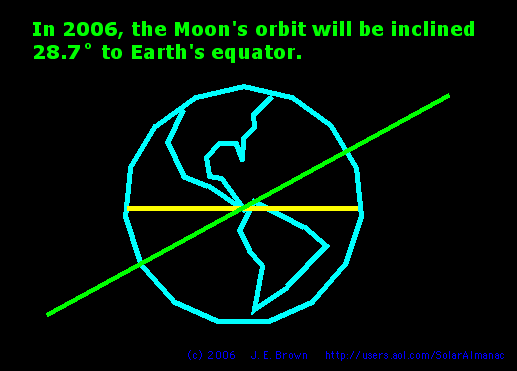 A press release from The Solar Almanac.
A press release from The Solar Almanac.
 A press release from The Solar Almanac.
A press release from The Solar Almanac.
Updated: November 28, 2006
by J. E. Brown
Has the Moon seemed to be all over the sky lately? It's not your imagination. Orbital precession, a slight periodic wobble in the Moon's orbit, sometimes brings the Moon to its extreme declinations (Earth latitudes) of 28.72 degrees north and south.

Full moons near the winter solstice are always striking, but this month's moon is special.
The full moons of December 2005 and December 2006 will be the lowest in 18 years for
Southern Hemisphere observers. For viewers in the Northern Hemisphere, north of the
tropics, these full moons will be the highest until 2024, with the full moon appearing
directly overhead as far north as The Bahamas, Iran, Nepal, Delhi, and the southern ends of
Morocco, Kuwait, and Tibet. In the US, the Moon will be overhead in Florida (Cape Kennedy)
and southern Texas, and not quite as far north as the Louisiana Delta. Observers below 60
south will see a very low full moon or none at all. At all locations, the Moon will rise
and set near its extreme northeast and northwest azimuths (unusually far NE/NW on the
horizon); look for this at sunrise and sunset.
(For technical reasons, full moons do not occur at declinations more extreme than 28.40 degrees.) {You're reading "Highest Full Moons in 18 Years" by J. E. Brown.}
Update: The current season of record high moons is slowly ending. Next winter's moons will be 0.5° lower. {Read this comp1ete article at http://jebrown.us/JEBrown800/PressReleases/HighestMoons120905.html .}
The full moons of December 2006 and January 2007, being equally spaced around the solstice, will be equally high overhead.
Note however that the high moon of December 2006 is the night after the full moon, because the Moon will reach its northernmost declination (28.4°) 27 hours after the moment of full moon.
To enjoy this phenomenon, go outside around local midnight the night of December 5-6, and notice how long (or short!) the shadows are (including yours).
Use this calculator to compute the best viewing time for your area.
|
|
J. E. Brown lives and breathes astronomy in Los Alamos, New Mexico USA. (more)
18.6 years, extreme declinations of the Moon, northernmost declination of the Moon, southernmost declination of the Moon, lunar standstill
 The Solar Almanac: This month's events in astronomy. Never miss a moon event.
The Solar Almanac: This month's events in astronomy. Never miss a moon event.
 Aurora Borealis over New Mexico
Aurora Borealis over New Mexico
 Vecpac, my C++ software for vector math and geometry
Vecpac, my C++ software for vector math and geometry
Copyright © 2005-2006 J. E. Brown all rights reserved. write me here Los Alamos, NM USA